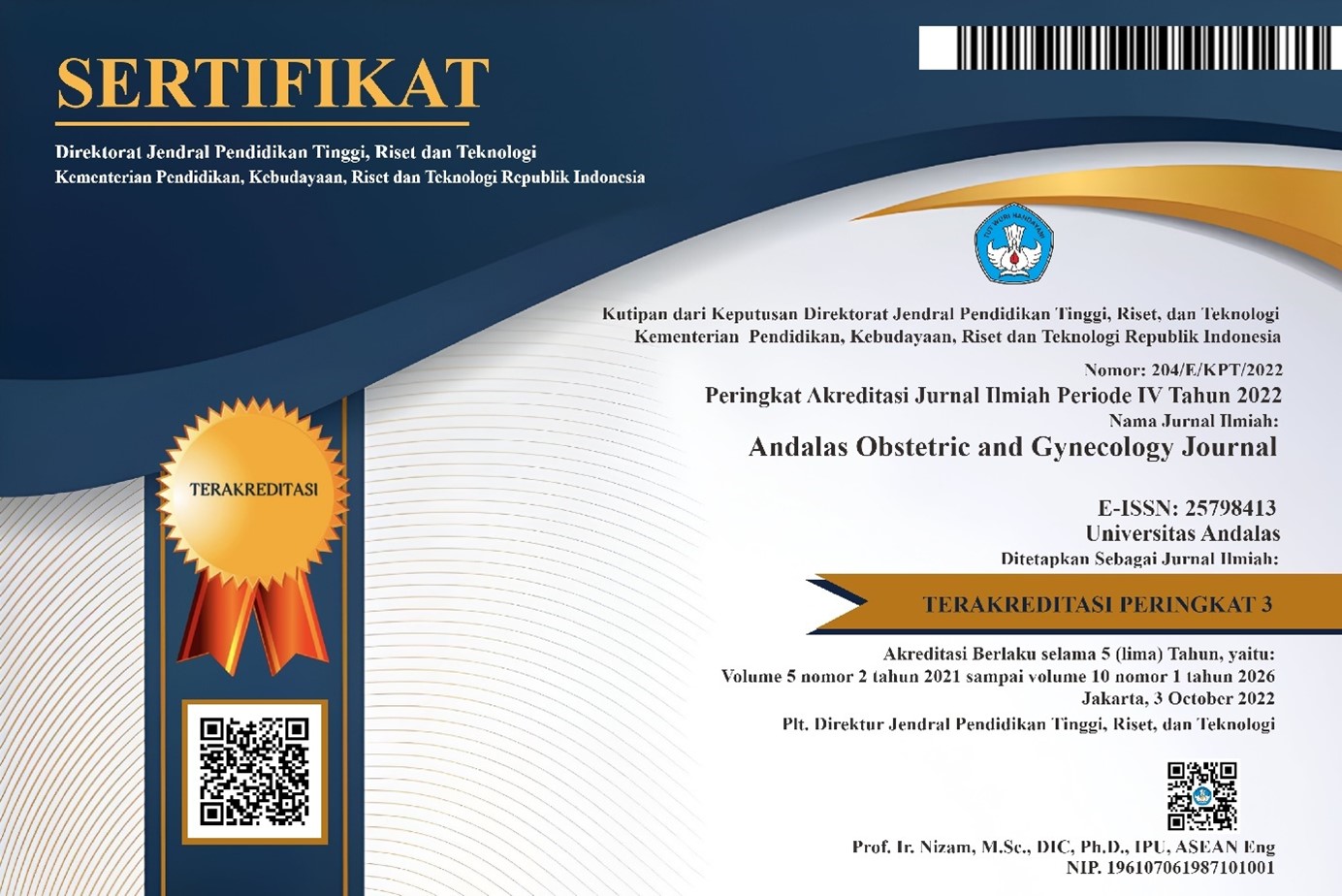Amniotic Fluid Embolism in Post Caesarean Section
DOI:
https://doi.org/10.25077/aoj.4.2.161-166.2020Abstract
Background: According to WHO, around 73% of maternal deaths globally are caused by direct obstetric causes. The amniotic fluid embolism is a life-threatening obstetric emergency characterized by sudden cardiopulmonary system failure and can be accompanied by Disseminated Intravascular Coagulation (DIC). The amniotic fluid embolism event usually occurs during labor and birth, but can also occur immediately in the post partum period or after pregnancy termination. About 56% of women will not survive for first 2 hours after the acute event. Amniotic fluid embolism is an unpredictable event, so that no prophylactic intervention can be carried out effectively and the handling and enforcement of a diagnosis that still debatable.
Objective: To report maternal deaths due to amniotic fluid embolism post cesarean section
Method: Case Report
Case:Â Reported case of a 30 years old woman with an initial diagnosis in emergency departement with decreased consciousness due to Severe hypoxia due to Pulmonary emboli due to Amniotic fluid emboli on P2A0L2 post Cesarean Section first day of puerperium. The patient experienced a sudden loss of consciousness accompanied by severe shortness of breath after 6 hours after cesarean section surgery in a private hospital. After initial examination and treatment by administering oxygen through the Nonrebreathing Mask, there was no improvement in the O2Â saturation value and then the patient was intubated by the anesthetist. After intubation, the O2Â saturation value still does not increase, then the patient suddenly experiences cardiac arrest and followed with cardiac resuscitation for 2 cycles accompanied by resuscitation drugs then the patient returns to spontaneous circulation. From the cardiology department, inotropic therapy was given and echocardiographic investigations were carried out. On echocardiographic examination, they found McConnel's sign which showed suspicios of pulmonary embolism. At the time the patient will be moved to the intensive care unit, the patient experiences a cardiac arrest for the second time, then resuscitation is performed again for 2 cycles, but it does not work and the patient is declared dead.
Conclusion: Amniotic fluid embolism is an obstetric emergency condition that cannot be predicted and has a high mortality rate. Treatment is supportive to support the cardiopulmonary system and management of coagulopathy that may occur.
Keywords: maternal mortality, amniotic fluid embolismÂ
References
WHO. World health statistics overview 2019 : monitoring health for the SDGs, sustainable development goals. Geneva: WHO; 2019.
Ministry of Health. Profil Kesehatan Indonesia 2018. Jakarta: Kementerian Kesehatan Republik Indonesia; 2019.
Maternal Mortality. Geneva: World Health Organization; 2014.
Sadera G, Vasudevan B. Amniotic fluid embolism. Journal of Obstetric Anaesthesia and Critical Care. 2015;5(1):3-8.
Hoyert DL. Maternal Mortality in the United States: Changes in Coding, Publication, and Data Release, 2018. Hyattsville: National Vital Statistics Reports; 2018.
UNICEF. Trends In Maternal Mortality: 2000 To 2017. Geneva: World Health Organization; 2019.
Chalid MT. Upaya Menurunkan Angka Kematian Ibu: Peran Petugas Kesehatan. Fakultas Kedokteran, Universitas Hasanuddin Press. 2018;8(2):1
Say L, Chou D, Gemmill A, Tunçalp Ö, Moller A-B, Jane Daniels, et al. Global causes of maternal death: a WHO systematic analysis. Lancet Global Health ; 2: e323–33. 2014;2:323 - 33.
Sundin CS, Mazac LB. Amniotic Fluid Embolism. MCN Am J Matern Child Nurs. 2017;42(1):29-35.
Fong A, Chau CT, Pan D, Ogunyemi DA. Amniotic fluid embolism: antepartum, intrapartum and demographic factors. J Matern Fetal Neonatal Med. 2015;28(7):793-8.
Bonnet MP, Zlotnik D, Saucedo M, Chassard D, Bouvier-Colle MH, Deneux- Tharaux C, et al. Maternal Death Due to Amniotic Fluid Embolism: A National Study in France. Anesth Analg. 2018;126(1):175-82.
Pacheco LD, Clark SL, Klassen M, Hankins GDV. Amniotic fluid embolism: principles of early clinical management. Am J Obstet Gynecol. 2020;222(1):48-52.
Downloads
Published
Issue
Section
License
Copyright (c) 2020 JOURNAL OBGIN EMAS

This work is licensed under a Creative Commons Attribution 4.0 International License.
Copyright
Authors who publish with this journal agree to the following terms:
- Authors retain the copyright of published articles and grant the journal right of first publication with the work simultaneously licensed under a Creative Commons Attribution 4.0 International License that allows others to share the work with an acknowledgment of the work's authorship and initial publication in this journal.
- Authors are able to enter into separate, additional contractual arrangements for the non-exclusive distribution of the journal's published version of the work (e.g., post it to an institutional repository or publish it in a book), with an acknowledgment of its initial publication in this journal.
- Authors are permitted and encouraged to post their work online (e.g., in institutional repositories or on their website) prior to and during the submission process, as it can lead to productive exchanges, as well as earlier and greater citation of published work (See The Effect of Open Access).
License:
Andalas Obstetrics and Gynecology Journal (AOJ) is published under the terms of the Creative Commons Attribution 4.0 International License. This license permits anyone to copy and redistribute this material in any form or format, compose, modify, and make derivatives of this material for any purpose, including commercial purposes, as long as they credit the author for the original work.







